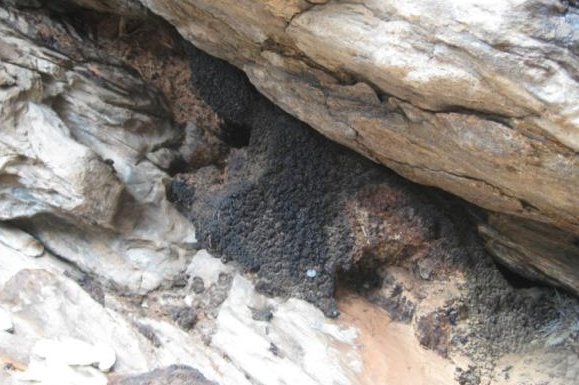A Pleistocene-age packrat midden is seen at City of Rocks National Reserve in south central Idaho. Photo by American Museum of Natural History
Feb. 21 (UPI) -- Packrats build complex nests featuring debris piles called middens. The piles are composed of plant material, as well as bits of insects, bones, fecal matter and urine.
Scientists at the American Museum of Natural History have developed a new technique for sequencing the DNA found in ancient packrat middens, yielding new insights into Earth's ecological past and offering researchers a new way to study the impacts of climate change on local plant and animal communities.
"Rodent middens are powerful tools in paleoecology," Michael Tessler, a postdoctoral fellow with the Sackler Institute for Comparative Genomics at AMNH, said in a news release. "We wanted to see how we could take this invaluable resource and expand its use to give us a big-picture view of what life in the Americas was like 1,000, 10,000 or even 30,000 years ago, and measure how it has changed in the time since then."
Packrats, or woodrats, comprise all 22 living species in the rodent genus Neotoma. When the animals urinate on their debris piles, the materials bind together. As the urine dries out, sugars and other compounds crystallize, further solidifying and preserving the debris.
Because packrats also build their nests in caves and crevices, and live in mostly arid places, the middens can preserve materials for thousands of years. Each midden contains material from within only a small range, offering a precise snapshot of the plant and animals that occupied the environment at that place and time. Since 1960, scientists have catalogued the remains of some 2,000 ancient packrat middens from western North America.
"Midden contents are so well preserved that fragments of ancient DNA can be extracted and analyzed across millennia," said Rob Harbert, an assistant professor at Stonehill College.
Harbert initiated the newly published study while working as a postdoctoral researcher at AMNH.
"They have been used to identify an extinct ground sloth preserved in southern Argentina, tell us about the history of bighorn sheep in California, and provided evidence of papillomavirus infection in packrats over the last 27,000 years," Harbert said. "Because of their dense distribution, fossil middens in the Americas offer the chance to genetically profile entire communities through time and space, but first, we need to improve the way we analyze data from these deposits -- the principal aim of this study."
For the study, Harbert and his research partners used two advanced sequencing techniques to compare the DNA in 25 different midden samples, ranging in age from 300 to 48,000 years old, from a midden collection at the University of Arizona's Tree Ring Laboratory. The packrat nests were collected from south-central Idaho and Northern Baja California, Mexico.
Their analysis, described in the journal Ecology and Evolution, showed that a large portion of the genetic material preserved in the mitten samples belonged to bacteria. But between 20 to 40 percent of the recognizable DNA fragments belonged to eukaryotes, organisms whose cells have a nucleus. The eukaryotes included plants such as grasses, pines, junipers, daisies and roses. Sequencing data also revealed the presence of insects and fungi, as well as small quantities of virus DNA.
Unfortunately, the shotgun sequencing method deployed by the researchers still needs further development. Without an extensive DNA database, scientists were only able to trace the DNA fragments to family level, not the genus or species.
"As the costs of DNA sequencing continue to decrease and computational power increases, the prospects for using this technique will greatly improve," Harbert said. "Further investigation into the taxonomic composition of middens could refine our understanding of the timeline of past climate change, species migration, and extinction, and this will better inform the study of the effects of current and future climate change."















